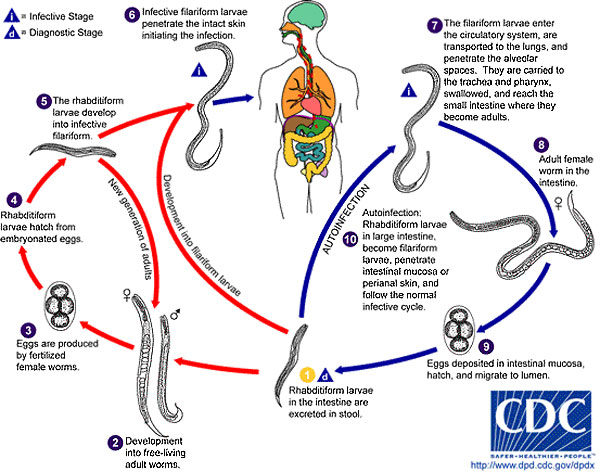File:Nematode - strongyloides lifecycle.jpg
Nematode_-_strongyloides_lifecycle.jpg (600 × 472 pixels, file size: 83 KB, MIME type: image/jpeg)
Nematode - Strongyloides Lifecycle
Complex nematode life cycle with its alternation between free-living and parasitic cycles, and its potential for autoinfection and multiplication within the host.
Free-living cycle
1. The rhabditiform larvae passed in the stool (see "Parasitic cycle" below) can either molt twice and become
6. infective filariform larvae (direct development)
or molt four times and become
2. free living adult males and females that mate
3. produce eggs
4. from which rhabditiform larvae hatch .
5. The latter in turn can either develop into a new generation of free-living adults (as represented in 2), or
6. into infective filariform larvae. The filariform larvae penetrate the human host skin to initiate the parasitic cycle (see below).
Parasitic cycle
6. Filariform larvae in contaminated soil penetrate the human skin, and are transported to the lungs where they penetrate the alveolar spaces;
7. they are carried through the bronchial tree to the pharynx, are swallowed and then reach the small intestine.
8. In the small intestine they molt twice and become adult female worms.
9. The females live threaded in the epithelium of the small intestine and by parthenogenesis produce eggs , which yield rhabditiform larvae. The rhabditiform larvae can either be passed in the stool (1. see "Free-living cycle" above), or can cause autoinfection .
10. In autoinfection, the rhabditiform larvae become infective filariform larvae, which can penetrate either the intestinal mucosa (internal autoinfection) or the skin of the perianal area (external autoinfection); in either case, the filariform larvae may follow the previously described route, being carried successively to the lungs, the bronchial tree, the pharynx, and the small intestine where they mature into adults; or they may disseminate widely in the body. To date, occurrence of autoinfection in humans with helminthic infections is recognized only in Strongyloides stercoralis and Capillaria philippinensis infections. In the case of Strongyloides, autoinfection may explain the possibility of persistent infections for many years in persons who have not been in an endemic area and of hyperinfections in immunodepressed individuals.
Geographic Distribution
Tropical and subtropical areas, but cases also occur in temperate areas (including the South of the United States). More frequently found in rural areas, institutional settings, and lower socioeconomic groups.
Reference
File history
Click on a date/time to view the file as it appeared at that time.
| Date/Time | Thumbnail | Dimensions | User | Comment | |
|---|---|---|---|---|---|
| current | 03:44, 1 June 2012 |  | 600 × 472 (83 KB) | Z8600021 (talk | contribs) | ==Nematode - Strongyloides Lifecycle== Complex nematode life cycle with its alternation between free-living and parasitic cycles, and its potential for autoinfection and multiplication within the host. ===Free-living cycle=== 1. The rhabditiform larv |
You cannot overwrite this file.
File usage
The following page uses this file:
